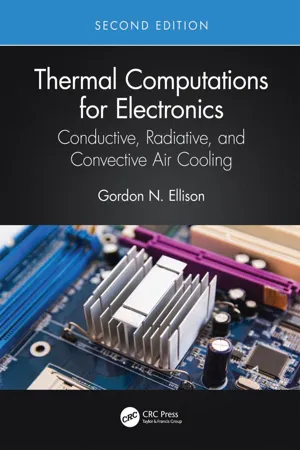
Thermal Computations for Electronics
Conductive, Radiative, and Convective Air Cooling
Gordon N. Ellison
- 382 pages
- English
- ePUB (mobile friendly)
- Available on iOS & Android
Thermal Computations for Electronics
Conductive, Radiative, and Convective Air Cooling
Gordon N. Ellison
About This Book
The first edition of Thermal Computations for Electronics: Conductive, Radiative, and Convective Air Cooling was based on the author's lecture notes that he developed over the course of nearly 40 years of thermal design and analysis activity, the last 15 years of which included teaching a university course at the senior undergraduate and graduate levels. The subject material was developed from publications of respected researchers and includes topics and methods original to this author. Numerous students have contributed to both the first and second editions, the latter corrected, sections rewritten (e.g., radiation spatial effects, Green's function properties for thermal spreading, 1-D FEA theory and application), and some new material added.
The flavor and organization of the first edition have been retained, whereby the reader is guided through the analysis process for systems and then components. Important new material has been added regarding altitude effects on forced and buoyancy driven airflow and heat transfer. The first 20% of the book is devoted to the prediction of airflow and well-mixed air temperatures in systems, circuit board channels, and heat sinks, followed by convective ( PCB -mounted components included), radiative, and conductive heat transfer and the resultant temperatures in electronic equipment. Detailed application examples illustrate a variety of problems.
Downloads (from the CRC website) include: MathcadTM text examples, exercise solutions (adopting professors only) plus PDF lecture aids (professors only), and a tutorial (Chapter 14) using free FEA software to solve a thermal spreading problem.
This book is a valuable professional resource for self-study and is ideal for use in a course on electronics cooling. It is well-suited for a first course in heat transfer where applications are as important as theory.
Frequently asked questions
Information
CHAPTER 1
Introduction
1.1 PRIMARY MECHANISMS OF HEAT FLOW
1.2 CONDUCTION
(1.1) |
Table of contents
- Cover
- Half Title
- Title Page
- Copyright Page
- Dedication
- Table of Contents
- Preface to the Second Edition
- Preface to the First Edition
- About the Author
- Acknowledgments
- Chapter 1 Introduction
- Chapter 2 Thermodynamics of airflow
- Chapter 3 Airflow I: Forced flow in systems
- Chapter 4 Airflow II: Forced flow in ducts, extrusions, and pin fin arrays
- Chapter 5 Airflow III: Buoyancy driven draft
- Chapter 6 Forced convective heat transfer I: Components
- Chapter 7 Forced convective heat transfer II: Ducts, extrusions, and pin fin arrays
- Chapter 8 Natural convection heat transfer I: Plates
- Chapter 9 Natural convection heat transfer II: Heat sinks
- Chapter 10 Thermal radiation heat transfer
- Chapter 11 Conduction I: Basics
- Chapter 12 Conduction II: Spreading resistance
- Chapter 13 Additional mathematical methods
- Appendix i: Physical properties of dry air at atmospheric pressure
- Appendix ii: Radiation emissivity at room temperature
- Appendix iii: Thermal conductivity of some common electronic packaging materials
- Appendix iv: Some properties of Bessel functions
- Appendix v: Some properties of the Dirac delta function
- Appendix vi: Fourier coefficients for a rectangular source
- Appendix vii: Derivation of the Green’s function properties for the spreading problem of a rectangular source and substrate - method A
- Appendix viii: Derivation of the Green’s function properties for the spreading problem of a rectangular source and substrate - method B
- Appendix ix: Proof of reciprocity for the steady-state Green’s function;
- Appendix x: Finned surface to flat plate h conversion
- Appendix xi: Some conversion factors
- Appendix xii: Altitude effects for fan driven airflow and forced convection cooled enclosures
- Appendix xiii: Altitude effects for buoyancy driven airflow and natural convection cooled enclosures
- Bibliography
- Index